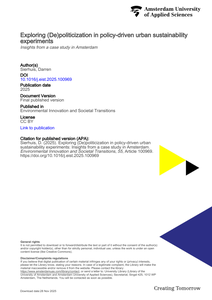DOCUMENT

DOCUMENT

Urban experimentation has gained traction with (supra-)national and local politics as a method for catalyzing change in urban systems and practices. Yet, with experiments becoming more commonly driven by established actors, concerns persist about their potential to sidestep political issues of power, exclusion and conflict fundamental to societal change. This paper seeks to unpack what exactly is at stake when the political is ignored or neutralized during an urban experiment. Using theories on the political as an analytical lens, the paper presents a case study of an urban experiment in Amsterdam, dissecting the ways in which (de)politicization operates in the experiment. The findings demonstrate that ignoring the political in urban experimentation risks excluding certain voices and options from being considered, which ultimately leads to stagnation. The paper concludes by outlining future challenges for research and practice that addresses (de)politicization in urban experiments.
MULTIFILE

Het zwaartepunt van de ingenieursopleiding is aan het verschuiven. De Utrechtse ingenieur zal zijn werk en toegevoegde waarde steeds meer vinden op het terrein van ontwerpen. Aan het ontwerpproces zelf worden steeds zwaardere eisen gesteld. Constructie en productie vinden in toenemende mate elders in de wereld plaats. Gelet op deze outsourcing zal de ontwerper ook in staat moeten zijn het maakproces op afstand te besturen, zowel wat betreft kwaliteit en geld als qua tijd. Ontwerpen kan vanuit verschillende perspectieven beschouwd worden: vanuit de conceptuele fase, de realisatiefase (verdere aanpassingen) of de gebruiksfase (upgrading, bediening et cetera). Bij onderzoeksinstellingen als TNO, maar ook bij vooraanstaande bedrijven als OCE, Philips en ASML zien we dat steeds meer sprake is van een integrale ontwerpaanpak. Het tijdperk van massaproductie evolueert naar een tijdperk van maatwerk, waarin de behoeften van de gebruiker centraal staan. De interactie tussen de technologie en de gebruiker zal een steeds belangrijker plaats in gaan nemen, en juist op dit vlak zal de Utrechtse ingenieur zich onderscheiden.
DOCUMENT

ABSTRACT Purpose: This short paper describes the dashboard design process for online hate speech monitoring for multiple languages and platforms. Methodology/approach: A case study approach was adopted in which the authors followed a research & development project for a multilingual and multiplatform online dashboard monitoring online hate speech. The case under study is the project for the European Observatory of Online Hate (EOOH). Results: We outline the process taken for design and prototype development for which a design thinking approach was followed, including multiple potential user groups of the dashboard. The paper presents this process's outcome and the dashboard's initial use. The identified issues, such as obfuscation of the context or identity of user accounts of social media posts limiting the dashboard's usability while providing a trade-off in privacy protection, may contribute to the discourse on privacy and data protection in (big data) social media analysis for practitioners. Research limitations/implications: The results are from a single case study. Still, they may be relevant for other online hate speech detection and monitoring projects involving big data analysis and human annotation. Practical implications: The study emphasises the need to involve diverse user groups and a multidisciplinary team in developing a dashboard for online hate speech. The context in which potential online hate is disseminated and the network of accounts distributing or interacting with that hate speech seems relevant for analysis by a part of the user groups of the dashboard. International Information Management Association
LINK
This article explores the development of skills of lecturers for internationalisation at home. It discusses backgrounds and the current situation, but also suggests ways forward. These suggestions are made mainly on the basis of experiences in The Netherlands, one of the few countries outside the English-speaking world, where a body of literature is emerging that discusses the implementation of internationalisation at home. The insights generated by this research may benefit universities in other countries in continental Europe, where English is not the standard language of instruction. Original Article at: https://www.zfhe.at/index.php/zfhe/article/view/1095
DOCUMENT

In this chapter, we first summarise the findings from the country chapters on the multiple meanings of SA, documenting terms, translations and contrasting understandings between citizens and public officials. Second, we highlight how civil mobilisation tends to be cyclical over time and is often mediated by brokers. Strategies to spur stakeholders into action rely on a delicate balance of both collaboration and confrontation. Third, we examine the responses from authorities to SAIs, finding that reactions are uneven and that all civic innovators fear appropriation or co-optation by officials. Fourth, we assess overall outcomes of Arab SAIs and highlight that the transformative potential of SAIs exists especially at municipal level, if four conditions for success are present (trust, proximity, endorsement, evaluation). We also point out that the actual outcomes of SAIs in Arab societies have, so far, been limited due to design deficiencies (emphasising short-term objectives and limited context sensitivity) or because of officials’ resistance in active or passive forms. We characterise SAIs as a discursive action format that is best understood with a relational approach to power. In a final section, we formulate recommendations for activists, officials and donors on how to make SAIs more effective.
MULTIFILE
This chapter offers a working definition of social accountability as any citizen-led action beyond elections that aims to enhance the accountability of state actors. We view social accountability as a broad array of predominantly bottom-up initiatives, aimed at improving the quality of governance (especially oversight and responsiveness) through active citizen participation. We also trace the evolution of SA as a concept in the literature over the past decades and, then, discuss some influential theoretic approaches to SAIs, pointing out strengths and weaknesses of each model. Finally, we suggest organising Arab SAIs into one of three categories: (1) transparency; (2) advocacy; or (3) participatory governance and we review each of these existing action formats by discussing their main strengths and flaws.
MULTIFILE